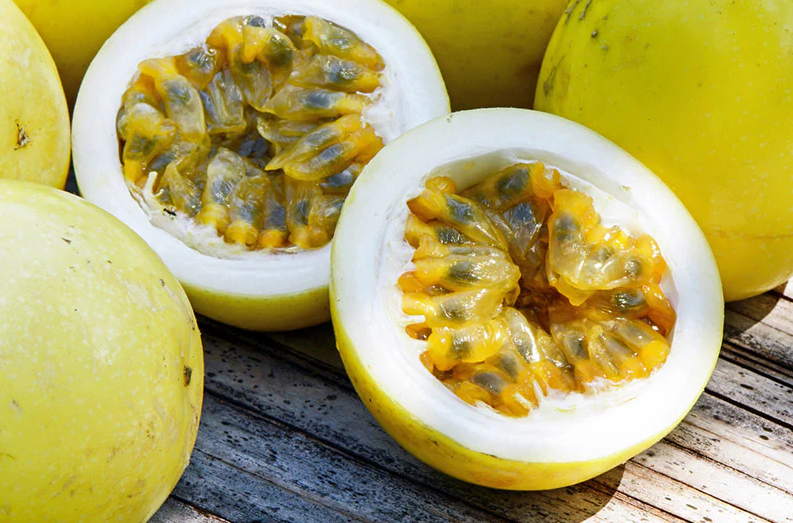
Maracuyas, also known as Yellow passionfruit botanically classified as Passiflora edulis f. flavicarpa, are a tropical species belonging to the Passifloraceae family. The plant most common species of passionfruit. The fruits grow on vigorous, evergreen climbing vines that naturally creep along nearby bushes, trellises, walls, fences, and trees. Maracuyas are native to subtropical climates throughout South and Central America.
The name Maracuya translates from Spanish to mean “passionfruit” and is a term primarily used to describe varieties of Yellow passionfruit, also known as Golden passionfruit. Within the Passiflora edulis species are two types of passionfruit: purple passionfruit or Passiflora edulis f. edulis, and Maracuya, Passiflora edulis f. flavicarpa. In Latin, flavicarpa means “yellow or gold.” It is also important to note that Maracuyas are distinct from granadillas, also known as sweet granadillas, which are fruits from a different species within the Passifloraceae family.
The fruit has a tough, smooth, waxy skin which can range from dark purple to light yellow or even orange when ripe. Inside, it contains a multitude of small, black seeds surrounded by a juicy, aromatic pulp. This pulp is what people usually consume. The taste of maracuya is quite unique, usually described as tart, sweet, and very aromatic. It can be quite tangy, which makes it excellent for balancing with sweeter flavors or for use in drinks and desserts.
You can eat it straight from the fruit with a spoon, although some prefer to strain out the seeds. Maracuya is widely used in juices, cocktails (like the famous Brazilian caipirinha or the passionfruit mojito), desserts, sauces, and as a flavoring for various dishes. Maracuyas pair well with fruits such as citrus, coconut, mango, and banana, chocolate, honey, vanilla, and herbs such as cilantro, mint, and rosemary.
Maracuyas are available year-round in tropical climates, with a peak season in the early summer through winter.
In many cultures, the passionflower (from which passionfruit comes) has been symbolic, often associated with the Passion of Christ due to the flower’s structure being interpreted as representing elements of the crucifixion.
Botanical Features
- Vine Characteristics: Maracuya vines are vigorous climbers, using tendrils to grip onto supports. They can grow quite long, often reaching up to 15-20 feet in a season if not pruned.
- Leaves: The leaves are typically deep green, glossy, and lobed, providing a lush backdrop for the flowers.
- Flowers: The flowers of the passionfruit are striking and complex, often considered among the most exotic-looking in the plant world. They are usually white with purple or pink accents, featuring a ring of coronal filaments, and are known for their unique structure which includes five stamens and a three-part style.
Cultivation
- Climate: Passionfruit thrives in subtropical and tropical climates but can tolerate light frosts. They prefer full sun but can handle partial shade.
- Soil: Well-drained, fertile soil is ideal. The plant is somewhat tolerant to various soil types but does best with good organic matter content.
- Watering: Regular watering is necessary, especially during dry periods, but overwatering should be avoided to prevent root rot.
- Support: Given their climbing nature, they require trellises, fences, or other structures to grow on.
- Pests and Diseases: The plant can be susceptible to various pests like caterpillars, aphids, and nematodes, and diseases like fusarium wilt or passionfruit woodiness virus, which can affect yield and plant health.